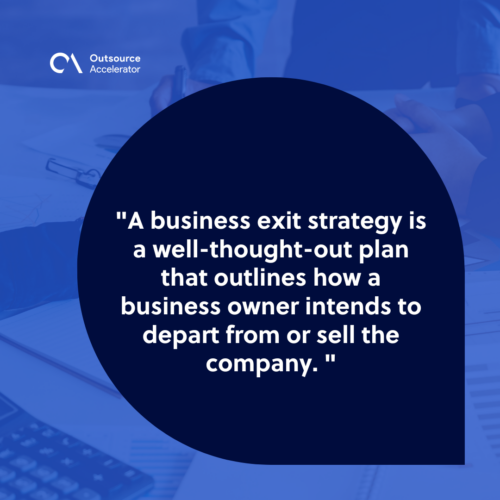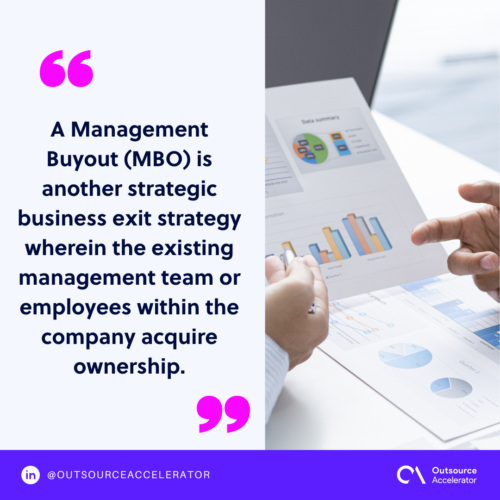What is a business exit strategy?

Embarking on a business venture is an exciting dream for many, but without careful planning, there’s a risk of potential losses.
The deadliest mistake that can cause doom for a business is often rooted in a lack of adaptability and financing. According to CMBC Insights, 44% of businesses fail due to poor financial planning.
Failure to adapt to market changes, emerging trends, or technological advancements can also prove fatal. In other words, organizations that are reluctant to embrace innovation may experience a loss of competitiveness.
No matter how well your business is doing, having a concrete business exit strategy is essential for every business owner.
What is a business exit strategy?
A business exit strategy is a well-thought-out plan that outlines how a business owner intends to depart from or sell the company.
It serves as a roadmap, detailing the steps and considerations for a smooth transition of ownership or a sale of the business.

This strategic plan is crucial for various reasons, such as:
- Securing the owner’s financial future
- Ensuring business continuity
- Aligning with the owner’s personal goals
Developing an effective exit strategy involves the following initiatives:
- Financial planning
- Succession planning
- Assessing the business’s current value
- Identifying suitable exit options
- Addressing legal and regulatory compliance
- Communicating with stakeholders
- Timing the exit for maximum value
Overall, a business exit strategy is a vital component of strategic planning that allows business owners to navigate changes and transitions with clarity and purpose.
Why create a business exit strategy?
Exiting a business without a plan can be risky. A well-thought-out exit strategy helps mitigate potential risks associated with market changes, economic downturns, or unforeseen events.
It helps entrepreneurs, especially with the following:
Financial safety net
It provides a safety net, allowing the owner to navigate uncertainties with a clear plan in place.
This strategic planning is crucial for ensuring a smooth and well-thought-out departure that maximizes the business’s value.
This is also beneficial for businesses thinking about downsizing or limiting their losses. It provides a financial safety net for the owner.
By unlocking the maximum value of the business, the owner can:
- Secure their financial future
- Pursue new ventures
- Address unforeseen circumstances
Seamless transfer of ownership
This strategy also ensures business continuity by laying out a plan for the seamless transfer of ownership or control. As a result, this prevents disruptions to operations.
Alignment with personal goals
Above all, don’t forget that business owners also have diverse personal goals, ranging from retirement to pursuing new ventures.
As such, an exit strategy aligns the business trajectory with the owner’s personal goals, ensuring a seamless transition from one phase of life to another.
Types of business exit strategies
Business owners, executives, and investors employ business exit strategies to either minimize losses or leverage gains.
Familiarizing yourself with the various types of enterprise exit plans and understanding when to apply them can maximize returns on business and financial assets.
Let’s explore them in more detail below:
Selling the business
Selling the business is a direct and common business exit strategy. This is where the business owner seeks a buyer interested in acquiring the entire enterprise, including assets and liabilities.
This process involves negotiations and due diligence to determine the fair market value of the enterprise.
The buyer could be an entrepreneur, another company looking for expansion, or even a competitor aiming to strengthen its market position.
The sale may include tangible assets like inventory and equipment, as well as intangible assets such as brand reputation and customer relationships.
The success of this strategy depends on effective marketing, thorough financial documentation, and finding the right buyer willing to meet the owner’s valuation.
Management Buyout (MBO)
A Management Buyout (MBO) is another strategic business exit strategy wherein the existing management team or employees within the company acquire ownership.
The management team pools resources, often including financial backing from external sources like private equity firms or banks, to buy the business from the current owner.
MBOs are an attractive option when the management team believes they can drive the business forward and capitalize on their familiarity with its inner workings.
This approach is particularly applicable when the current management possesses an in-depth understanding of the business and its operations.
It provides continuity for employees, and the transition tends to be smoother since the acquiring party is already familiar with the company’s culture and processes.

Mergers and Acquisitions (M&A)
Mergers and Acquisitions (M&A) represent a strategic approach to business exit involving the union of two businesses. This can occur when two entities combine forces—or through the outright purchase of one business by another.
M&A offers business owners substantial financial gains or an ownership stake in the newly formed entity.
In the context of a merger, businesses consolidate resources, talents, and market shares, aiming for synergy that enhances overall competitiveness.
On the other hand, a business acquisition allows a business to absorb another company’s assets and customer base, often leading to increased market influence.
The success of an M&A exit strategy depends on careful negotiations, due diligence, and alignment of business goals to ensure seamless integration.
This business exit technique remains a popular option for those seeking a substantial payout or a continued stake in a more formidable business entity.
Initial Public Offering (IPO)
For businesses that are after significant growth potential, an Initial Public Offering (IPO) is a viable exit strategy. This intricate process involves the company making its shares available to the public for the first time, thereby entering the stock market.
An IPO provides an opportunity for the business owner to monetize their stake in the company, converting ownership into publicly traded shares.
Simultaneously, the business gains access to public capital markets, fostering the potential for further expansion and development.
Business owners considering an IPO as their exit strategy should assess the following factors:
- Market conditions
- Investor’s risk appetite
- Long-term private ownership
Strategic alliances and partnerships
This business exit strategy is considered as a collaborative approach that manifests in various forms:
- Joint ventures
- Strategic partnerships
- Alliances with other businesses
Through these arrangements, the owner can strategically exit the business while retaining a stake in its ongoing operations.
Joint ventures often involve shared resources and responsibilities, allowing for a smooth transition of ownership. Meanwhile, strategic partnerships may involve collaboration on specific projects or market initiatives, providing an avenue for the owner to step back gradually.
This strategy not only facilitates a seamless exit but also opens doors to new growth opportunities and expanded market reach.
Passing to family successors
Passing the business down to family successors is another common business exit strategy, especially in family-owned enterprises. It involves the identification and training of family members to assume leadership roles within the business.
This strategy is rooted in preserving the family legacy and continuity of the business through subsequent generations.
Franchising
Franchising serves as an easily replicable business exit model. In this approach, the business owner grants others the right to operate under their established brand, utilizing a proven business formula.
Franchisees take on the day-to-day responsibilities of individual locations. This setup allows the owner to expand the brand’s reach without the managerial burdens associated with operating each outlet.
This method provides an avenue for business growth and generates revenue through franchise fees and ongoing royalties.
Franchising offers a win-win scenario, enabling the owner to capitalize on the established brand while offering aspiring entrepreneurs an opportunity to operate their businesses.
License agreements
This represents a unique exit strategy wherein the business owner grants permission for others to use specific intellectual property, such as trademarks or patents, in exchange for royalties.
This business exit plan provides a source of income for the owner without requiring active involvement in day-to-day business operations.
License agreements can be particularly beneficial for businesses with valuable intellectual property but limited resources or interest in managing the operational aspects.
By licensing the use of their intellectual assets, owners can monetize their creations, allowing others to leverage the established brand or technology.
This approach facilitates a passive income stream while freeing the original owner from the demands of running the business. This makes it an attractive exit strategy for those looking to shift focus or pursue other ventures.
How to create a business exit strategy
Here are the easy ways on how you can create an effective business exit strategy:
- Begin by evaluating the current value of your business. Understand its financial standing, assets, market position, and potential for growth.
- Explore various exit options based on your goals and the nature of your business. Refer to the types of business exit strategies above.
- Engage in thorough financial planning to ensure your post-exit financial security.
- Invest time in succession planning. Identify and groom potential leaders within the organization to ensure a seamless transition.
- Ensure compliance with industry regulations and verify that all contracts and agreements are in order to avoid complications during the exit process.
- Maintain clear communication with employees, customers, suppliers, and other stakeholders throughout the exit process.

Questions to ask for your business exit strategy
Before you decide on exiting your business, ask the following questions:
- What are my personal and financial goals? Understanding your objectives is crucial for aligning the exit strategy with your aspirations.
- Is the business ready for an exit? Assess the readiness of your business by evaluating its financial health, market position, and operational efficiency.
- How will the exit impact employees and stakeholders? Consider the implications of your exit on employees, customers, suppliers, and other stakeholders. Plan for a smooth transition.
- What legal and regulatory considerations should be addressed? Address any potential legal issues before executing the exit.
- What are the tax implications of the exit? Understand the tax implications associated with different exit strategies and plan accordingly to optimize your financial outcome.
When to use a business exit strategy
The implementation of a business exit strategy is a critical consideration for entrepreneurs and business owners, and the timing of its use is paramount.
While it depends on whatever reasons you may have, if your personal goals shift, such as retirement plans or pursuing new ventures, it may be the right time to consider an exit strategy.







 Independent
Independent




